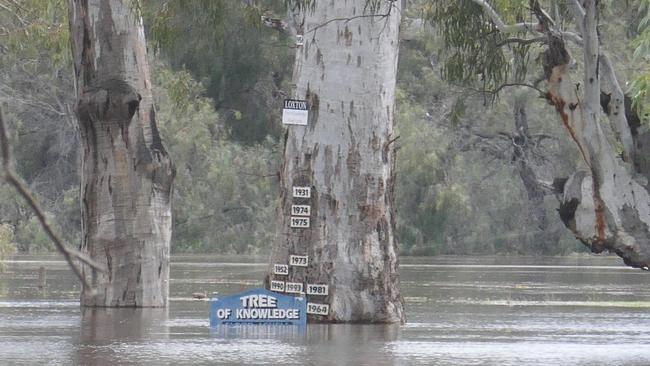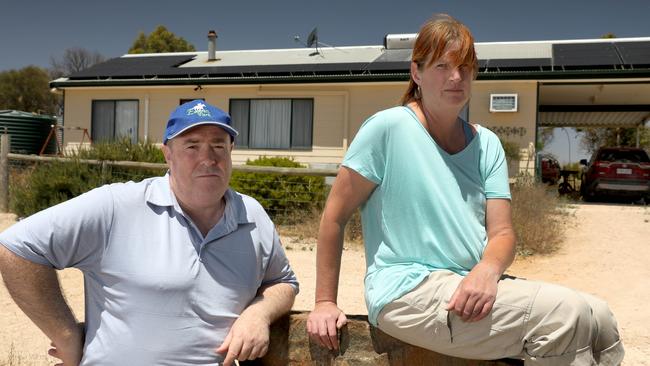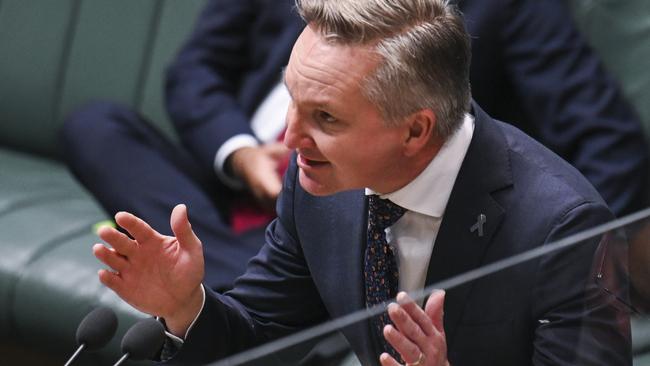These are not just one-in-100-year floods anymore | Kathryn Bermingham
Has anyone else noticed that once in a century disasters seem to happen regularly now, writes Kathryn Bermingham.
Opinion
Don't miss out on the headlines from Opinion. Followed categories will be added to My News.
The Tree of Knowledge in Loxton tells the story of generations of people living in communities along the River Murray in South Australia.
As more and more floods were added, it must also have seemed a glimpse at what the future would hold.
The highest level on the tree, and on similar markers throughout the Riverland, records the flood of 1956, when waters peaked above 12m in some towns.
In the decades that followed, the river flooded repeatedly. And as they did this time, locals over the years have prepared for them and endured them. And, as they will again this time, cleaned up in their aftermath.
But the experience of Australians with natural disasters is changing – and the way governments and communities respond should evolve too.
As federal Climate Change Minister Chris Bowen put it this week: “Natural disasters are increasingly frequent, more intense, and natural disasters are increasingly less natural”.
“Floods that were once regarded as once in 100 years or more are happening once every 10 years or less,” he said.
“That is not a coincidence.

“Climate change increases the amount of precipitation and increases the amount of flooding.” As the flooding emergency in the Kimberley escalates, and damage worsens in parts of NSW, Mr Bowen urged Australians to acknowledge the impact of climate change and “recognise it as a country”.
There is no question Australia must ramp up efforts to address climate change, and prioritise net-zero emissions targets.
But further to this, as we face the reality of more floods and bushfires, it’s clear that more should be done to better protect communities when disaster inevitably strikes.
Better regulation of the insurance industry – so that floods cannot be unreasonably used as an excuse to turn away customers or jack up prices – would be a good place to start.
One of the many issues currently faced by thousands of South Australians is the blanket “embargoes” that insurance providers have placed on postcodes along the length of the river.
Under the practice, residents are barred from taking out new policies and are generally not allowed to change their level of coverage. Those who are renewing their policies are reporting that premiums have doubled or more.

The bans are illogically applied to entire postcode areas, meaning even those living on much higher ground several kilometres away from the river are subject to the restrictions. The Advertiser this week highlighted the situation of Peter and Linda Medhurst, who live in the Adelaide Hills at Rockleigh on a property Mr Medhurst said will “never get flooded unless the ice caps melt”.
They are 20km from the river but the address is included in the large postcode area of 5254, along with river towns including Murray Bridge and Mypolonga.
For this reason, they have found themselves in the middle of bushfire season and unable to take out a home insurance policy.
And for those who do live close to the flooded areas, and are at risk of inundation, embargoes and jacked up home insurance premiums are more problems they must deal with amid their current predicament.
Embargoes and their associated complexities aside, the Insurance Council of Australia described insurance as “a critical financial safeguard, protecting homes across Australia from the full financial impact of disaster”.
It offers peace of mind and a crucial safety net during times that could otherwise lead to financial ruin.

But, in some places, “the affordability and availability of insurance is under severe strain”.
“There are actions governments can take to reduce flood risk at a community and property level and bring down the cost of premiums,” a council spokeswoman said this week.
The council is calling on governments to increase the level of investment in community and household mitigation, including in levees and floodproofing homes.
They also want to see changes to land use planning arrangements, so that no more homes are built on flood plains, and the inclusion of a resilience measure in the National Construction Code.
A further recommendation was to remove state taxes on insurance, which the council said only serve to push up the cost of premiums and discourage adequate insurance.
These are practical suggestions with the potential to make a real difference in times of crisis.
Since the beginning of SA’s flooding crisis, the state government has been appropriately forthcoming with financial assistance for those affected.
In November, a $51.6m initial financial assistance package was unveiled, while other supports have included further $300 payments announced this week for low-income earners and pensioners affected by ferry closures.
As the waters subside and the clean-up begins, the full extent of the damage and the cost of repairs will become more clear. It will be undoubtedly hefty.
If we can bank on future floods – and we can – it is essential to invest more in mitigation measures and better prepare communities to minimise the blow during future emergencies.





